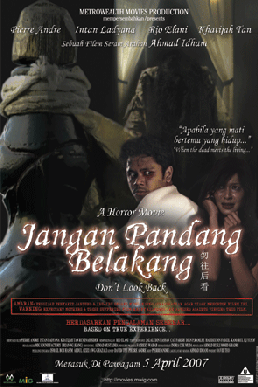
A toyol or tuyul is an undead infant in Indonesian and Malay folklore. It also appears in the various other mythologies of Southeast Asia and is typically invoked as a helper by shamans by means of black magic. A common use for the toyol includes using it for financial gain, where the creature robs people of their riches, making it similar to the Babi ngepet, a boar demon in Indonesian mythology, and the Hantu Raya, a familiar spirit in Malay folklore. As such, the toyol is popularly known to bring good luck to its host, but mishap to those who are unfortunate to encounter them.

The cinema of Malaysia consists of feature films produced in Malaysia, shot in the languages Malay, Mandarin, Cantonese, Tamil, various indigenous languages, and English.

Joko Anwar is an Indonesian film director, producer, screenwriter, and actor. Prior to becoming a filmmaker, he worked as a journalist and film critic.

Southeast Asian cinema is the film industry and films produced in, or by natives of Southeast Asia. It includes any films produced in Brunei, Cambodia, East Timor, Indonesia, Laos, Malaysia, Myanmar, the Philippines, Singapore, Thailand and Vietnam. The majority of the films made in this region came from the Philippines, Thailand, and Indonesia where its filmmaking industries in these countries are already well-established with film directors such as Lino Brocka, Apichatpong Weerasethakul, and Joko Anwar are well-known outside of the region. Notable production studios in Southeast Asia include Star Cinema, TBA Studios and Reality Entertainment in the Philippines, GDH 559 and Sahamongkol Film International in Thailand, Rapi Films in Indonesia, Encore Films in Singapore, and Studio 68 in Vietnam

Jangan Pandang Belakang is a 2007 Malaysian Malay-language supernatural horror film directed by Ahmad Idham starring Pierre Andre, Intan Ladyana, Khatijah Tan and Ruminah Sidek.

Bangjong Pisanthanakun is a Thai filmmaker and screenwriter. He saw early success with his first two films, Shutter (2004) and Alone (2007), both horror films that he co-directed and co-wrote with Parkpoom Wongpoom. He also directed the 2013 comedy horror romance film Pee Mak, which became Thailand's highest-grossing film of all time, and the 2021 horror film The Medium, which was a commercial and critical success in South Korea. In addition to horror films, Bangjong directed the romance films Hello Stranger (2010) and One Day (2016).

Geng: The Adventure Begins is a 2009 Malaysian Malay-language 3D animated adventure film. Based on the characters created by Les' Copaque, the film was directed by Nizam Razak from the screenplay of his friend, Anas Abdul Aziz and Ehsan Azharuddin and story by Nizam, Anas and Ainon Ariff who served as producer.

Pee Mak is a 2013 Thai supernatural romantic comedy-horror film directed and co-written by Banjong Pisanthanakun. The story is an adaptation of the Mae Nak Phra Khanong legend of Thai folklore. It was released on 28 March 2013. The film stars Mario Maurer as Mak Davika Hoorne as Nak, and Pongsathorn Jongwilas, Nattapong Chartpong, Auttarut Kongrasri and Kantapat Permpoonpatcharasook. The film was a major commercial success upon its release and became Thailand's highest-grossing film of all time.

Nan Triveni Achnas is an Indonesian film director.
Ghulam-Sarwar Yousof was a Malaysian academic and writer. He was an expert in traditional Malay and South-East Asian theatre as well as one of the leading writers of Malaysian English Literature.

The Garden of Evening Mists is a 2019 Malaysian English-language historical drama film directed by Tom Lin Shu-yu from the screenplay of Richard Smith and adapted from Tan Twan Eng's 2012 novel of same name. A woman, still haunted by her experiences in a Japanese internment camp as a child, travels to Cameron Highlands during the Malayan Emergency and becomes the apprentice of a mysterious Japanese gardener. It stars Lee Sin-je, Sylvia Chang and Hiroshi Abe.
Pontianak is a 1957 Malay horror film directed by Indian film director Balakrishna Narayana Rao, popularly known as B.N. Rao, and starring Maria Menado and M. Amin. Based on the Malay folktales of a blood-sucking ghost born from a woman who dies in childbirth, the smash hit premiered on 27 April 1957 and screened for almost three months at the local Cathay cinemas. Its success spawned two other sequels, Dendam Pontianak and Sumpah Pontianak. It is also said to have launched the Pontianak genre in Malaysia and Singapore, with rival Shaw producing its own Pontianak trilogy and several movies of the same genre were also made in Malaysia.

Upin & Ipin: The Lone Gibbon Kris is a 2019 Malaysian Malay-language animated adventure film. The film follows the adventure of the twins and their friends in the fantastical kingdom of Inderaloka, where they have to save the kingdom from the evil king called Raja Bersiong. It is the third feature film based on the animated TV series Upin & Ipin by Les' Copaque Production, after Geng: The Adventure Begins in 2009 and Upin & Ipin: Jeng Jeng Jeng! in 2016. With a budget of RM20 million, it is the most expensive Malaysian animation and film ever made.
Two Sisters is a 2019 Malaysian Mandarin-language psychological horror film by James Lee. The film follows two sisters who reunite after one of them is discharged from the asylum. As they move back to their abandoned haunted family house, a tragic family secret unfolds.

Wet Season is a 2019 Singaporean drama film written, produced and directed by Anthony Chen. In the film, a teacher and a student in Singapore secondary school form a special, self-affirming relationship. The film stars Yeo Yann Yann and Koh Jia Ler. It received positive reviews and was released on 28 November 2019 in Singapore.

Impetigore is a 2019 horror film written and directed by Joko Anwar. The film stars Tara Basro, Marissa Anita, Christine Hakim, Asmara Abigail, and Ario Bayu. The film follows Maya (Basro), who travels with her friend Dini (Anita) to her remote ancestral village seeking an inheritance.
Folk horror is a subgenre of horror film and horror fiction that uses elements of folklore to invoke fear and foreboding. Typical elements include a rural setting, isolation, and themes of superstition, folk religion, paganism, sacrifice and the dark aspects of nature. Although related to supernatural horror film, folk horror usually focuses on the beliefs and actions of people rather than the supernatural, and often deals with naïve outsiders coming up against these. The British films Blood on Satan's Claw (1971), The Wicker Man (1973) and Witchfinder General (1968) are regarded as pioneers of the genre, while the 2019 film Midsommar sparked renewed interest in folk horror. Southeast Asian cinema also commonly features folk horror.

Indonesian horror are the films of the horror genre produced by the Indonesian film industry. Often inspired by local folklore and religious elements, Indonesian horror films have been produced in the country since the 1960s. After a hiatus during the Suharto era in the 1990s, when censorship affected production, Indonesian horror films continued being produced following Reformasi in 1998.
Thai horror refers to horror films produced in the Thai film industry. Thai folklore and beliefs in ghosts have influenced its horror cinema. Horror is among the most popular genres in Thai cinema, and its output has attracted recognition internationally. Pee Mak, for example, a 2013 comedy horror film, is the most commercially successful Thai film of all time.














